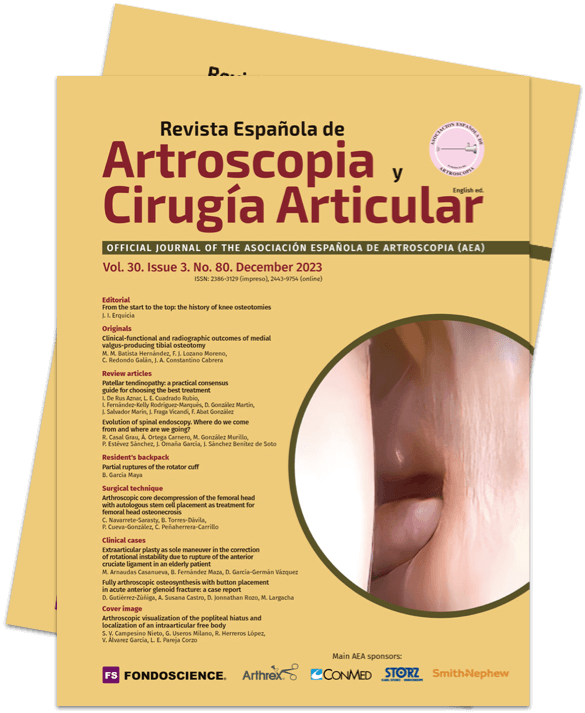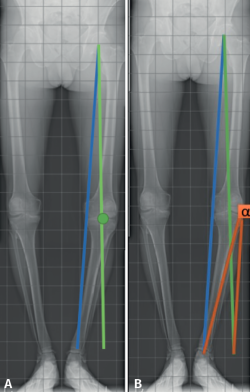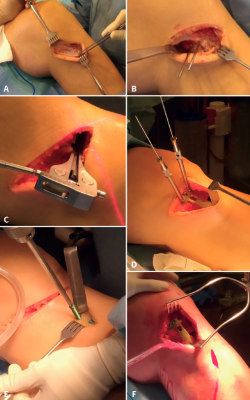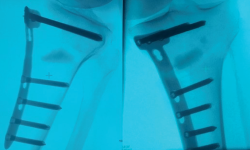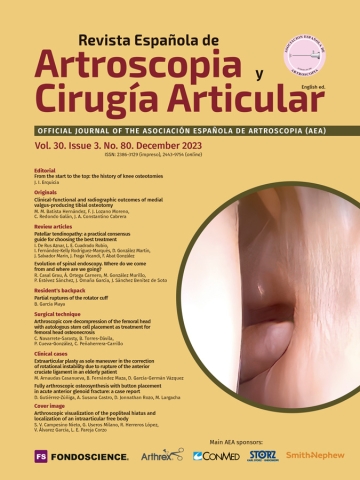Clinical-functional and radiographic outcomes of medial valgus-producing tibial osteotomy
Resultados clínico-funcionales y radiográficos de la osteotomía tibial de apertura medial valguizante
Resumen:
Objetivos: evaluar el resultado clínico, funcional y radiológico de los pacientes operados de una osteotomía valguizante de apertura tibial. Analizar si la percepción clínica subjetiva de los pacientes varía según el índice de masa corporal (IMC), el tiempo transcurrido desde la intervención quirúrgica y el grado de corrección del eje mecánico.
Métodos: estudio observacional, descriptivo y retrospectivo de pacientes operados mediante osteotomía tibial valguizante de apertura medial entre 2014 y 2019. Se recogieron variables demográficas (sexo/edad) e IMC. Se midieron el ángulo femorotibial, los milímetros desde el eje mecánico al punto de Fujisawa, y el índice de Insall-Salvati, pre- y posquirúrgicos. El grado de satisfacción fue valorado según el Knee Injury and Osteoarthritis Outcome Score (KOOS).
Resultados: se han realizado 35 osteotomías en 31 pacientes (26 hombres), siendo la edad media de 50,5 (40-63) años. El tiempo medio de seguimiento fue de 43,65 (12-80) meses. El ángulo femorotibial anatómico medio prequirúrgico fue de 2,5° de varo y la media del eje posquirúrgico, de 4,13° de valgo. El valor medio desde el eje mecánico hasta el centro de la articulación antes de la cirugía fue de 34,13 mm y se redujo a 14 mm. El índice de Insall-Salvati no varió. Para KOOS de síntomas, se obtiene un resultado de 88,5; para dolor, 76; para actividades cotidianas, 74,3; para actividades deportivas, 53,8; y para calidad de vida, 67,5. Los pacientes experimentaron sobre todo mejoría del dolor y de la sintomatología clínica.
Conclusiones: la osteotomía valguizante de apertura tibial medial es un procedimiento útil para personas con vida activa en un rango de edad media, con buenos resultados clínico-radiológicos a corto y medio plazo.
Abstract:
Objectives: An evaluation was made of the clinical-functional and radiographic outcomes of patients subjected to valgus-producing tibial osteotomy. In addition, an analysis was performed to determine whether the subjective clinical perceptions of the patients vary according to body mass index (BMI), the time elapsed from surgery, and the degree of correction of the mechanical axis.
Methods: A retrospective, descriptive observational study was made of patients subjected to medial valgus-producing tibial osteotomy between 2014 and 2019. Demographic variables (gender / age) and BMI were recorded. Measurements were made of the femorotibial angle, the distance (in mm) from the mechanical axis to the Fujisawa point, and the Insall-Salvati index, before and after surgery. The degree of satisfaction was evaluated using the Knee Injury and Osteoarthritis Outcome Score (KOOS).
Results: A total of 35 osteotomies in 31 patients (26 males) were carried out. The mean patient age was 50.5 years (range 40-63). The mean duration of follow-up was 43.65 months (range 12-80). The presurgical mean anatomical femorotibial angle was 2.5º varus, and the postsurgical mean axis angle was 4.13º valgus. The mean distance from the mechanical axis to the center of the joint was 34.13 mm before surgery, and this distance was reduced to 14 mm after the operation. The Insall-Salvati index showed no variations. The KOOS symptoms score was 88.5. The score for pain was 76, activities of daily living 74.3, sports activities 53.8, and quality of life 67.5. The patients experienced improvement particularly in relation to pain and clinical symptoms.
Conclusions: Medial valgus-producing tibial osteotomy is useful for patients leading active lives and in the middle age range, affording good clinical and radiological outcomes over the short and middle term.
Introduction
Gonarthrosis is a chronic degenerative condition of the knee(1). It is increasingly common and poses an important health problem for the current population(2), particularly due to the increase in life expectancy and obesity(3). The degree of osteoarthrosis is defined both clinically and radiologically(1). The medial compartment is most often affected, causing varus gonarthrosis. In order to prevent the progression of this kind of deformity, use can be made of medial valgus-producing tibial osteotomy, which realigns the knee and redistributes loading(2). It has been shown that this procedure alleviates pain and improves the function of the knee, particularly in middle-aged patients, affording good quality of life and delaying and/or avoiding the need for knee replacement surgery(4). In relation to other types of osteotomies performed as treatment for gonarthrosis (e.g., external subtraction osteotomy), valgus-producing tibial osteotomy avoids possible damage to the external popliteal sciatic nerve, keeps the proximal tibiofibular joint intact, preserves bone stock, and is technically more simple to perform(5).
The present study reviews the clinical-functional and radiological outcomes of medial valgus-producing tibial osteotomy in a sample of patients, and explores whether these outcomes have an impact upon patient quality of life and pain perception, using as parameters the body mass index (BMI), the time elapsed from surgery, and the degree of correction of the mechanical axis.
Material and methods
A retrospective observational study was carried out in patients subjected to valgus-producing tibial osteotomy due to knee arthrosis caused by genu varum, between April 2014 and December 2019.
A total of 35 osteotomies in 31 patients (5 females and 26 males) were carried out. The mean patient age was 50.5 years (range 40-63). Patient follow-up extended from the date of surgery to December 2020, with a mean duration of follow-up of 43.7 months (range 12-80). The study sample consisted of consecutive patients.
The sample characteristics are reported in Table 1.
The inclusion criteria were: patients with an active lifestyle, varus gonarthrosis, Ahlbäck II-III, with pain in the compartment, limiting quality of life, no involvement of the external compartment, the absence of associated comorbidities (such as inflammatory joint disorders) and BMI < 40 kg/m2.
Quality of life after surgery was assessed based on the Knee Injury and Osteoarthritis Outcome Score (KOOS) for each operated knee(6).
Preoperative planning
The method of Miniaci was used to plan osteotomy(7,8,9). In the teleradiographic study of the lower extremities, we traced the real mechanical axis (or Mikulicz line, extending from the center of the femoral head to the center of the ankle) and the desired mechanical axis (in our case we used the Fujisawa point, at 62.5% of the total width of the tibial plateau, measured from its medial margin)(10). Taking as vertex a point located 1 cm below the external joint line, immediately above the head of the fibula, we traced two lines to the ankle, joining with the two aforementioned axes traced at that level. This yielded the alpha correction angle (α), which represents the opening wedge to be used to obtain the desired postoperative correction (Figure 1).
Surgical technique
All the patients were operated upon by the same surgeon, with use of the standard TomoFix® plate as osteosynthesis material.
reacae.30380.fs2201001en-figure2.png

Figure 2. Medial osteotomy surgery. A: medial approach, direct visualization of the medial collateral ligament (MCL) and goosefoot; B: needles placed as guides for the horizontal arm of the osteotomy; C: calibrator of the osteotomy angle after opening with the chisels; D: plate fixation of the opening, after wedge positioning; E: placement of distal screws; F: final plate position.
Osteotomy was performed adopting a medial oblique approach. The pes anserinus (goosefoot) and anterior most portion of the inner lateral ligament (ILL) were partially deinserted in order to secure wide exposure of the proximal tibial epiphysis. Then, two parallel 3-mm needles (one anterior and the other posterior) were inserted from 3-4 cm below the medial joint line to the lateral point used as vertex of the correction angle. These two needles served as guides for the horizontal arm of the osteotomy. In the anterior portion, at the level of the anterior tibial tuberosity (ATT), we performed the osteotomy perpendicular to the anterior needle, posterior to ATT and guided proximally. After completing the cutting sequence, the chisels were inserted without reaching the external cortical layer, followed by the distractor, until achieving opening of the osteotomy with the planned α angle. Following the above, the graft wedge was inserted in the created opening ChronOS®) and was fixed with a TomoFix® plate screwed proximal and distal (both from DePuy Synthes) (Figures 2 and 3).
The postoperative protocol included early mobilization, avoidance of weight bearing for 6 weeks, and periodic teleradiography controls to check consolidation.
Statistical analysis
A Microsoft Excel® (version 18) database was created for comparing the results of the KOOS and the time from surgery, postoperative BMI, and degree of correction of the axis. The IBM SPSS version 28.0 statistical package was used to analyze the data. The values were reported as the mean ± standard deviation (SD). Data normality tests were performed Parametric tests (Pearson correlation coefficient) were used in the case of variables showing a normal distribution, while nonparametric testing (Spearman correlation coefficient, ρ) was used for variables with a non-normal distribution.
In the statistical program, the values of the coronal axis were expressed as negative values for varus and positive values for valgus.
Results
Of the 31 patients (35 knees) initially included in the study, only 28 (32 knees) were evaluated at least one year after surgery (91% follow-up rate).
The results were classified into 5 subscales (symptoms, pain, activities of daily living, sports activities and quality of life) within the KOOS. Specifically, the symptoms score was 88.5, the score for pain was 76, activities of daily living 74.3, sports activities 53.8, and quality of life 67.5 (Table 2).
Only two patients required total knee replacement surgery (TKR) due to the persistence of pain in the internal compartment after the initial osteotomy: one patient at one year postsurgery, and the other after two years.
Table 3 reports the mean values corresponding to the radiological findings of the sample: correction of the femorotibial angle or anatomical axis (postoperative valgus values of 5-7º being regarded as normal), reduction of the distance of the mechanical axis after the operation, and the Insall-Salvati index for the patella. Among the 35 osteotomies, the presurgical mean anatomical femorotibial angle was 2.5º varus, and the postsurgical mean axis angle was 4.13º valgus. Of the 34 patients, 53% (n = 18) achieved a valgus femorotibial angle of between 5-7º. However, although only approximately one-half of the patients reached the valgus target of between 5-7º, the mean difference between the pre- and postoperative axes was 6.6º (p < 0.001).
We also measured the distance of the mechanical axis of each knee to the Fujisawa point, before and after surgery. This distance was seen to decrease secondary to varus reduction of the operated knees. Specifically, from the initial mean distance of 34.13 mm, a mean reduction to 14 mm was achieved (with a mean reduction of 22.22 mm).
The mean pre- and postoperative Insall-Salvati index values were 0.88 and 0.84, respectively. The mean of the differences between the pre- and postoperative index values was 0.03. This difference was statistically significant.
After analyzing the clinical and radiological outcomes, we explored whether there was a relationship between the KOOS scores and the time elapsed from surgery, postoperative BMI, and the degree of correction of the mechanical axis after surgery.
- With regard to the follow-up time from surgery, the results of the KOOS were correlated for each subcategory to the follow-up time of the 32 osteotomies. No statistically significant correlation (p<0.05) was found between the time from surgery and the results of the KOOS questionnaire. This was a negative correlation, i.e., the longer the time from surgery, the lower the KOOS score.
- In relation to BMI, no correlation was found between this index and the results of the KOOS questionnaire.
- In the case of the postsurgical valgus axis, we analyzed the correlation between the clinical results (mean total KOOS score of the patients) and the degree of postsurgical correction achieved. This was a positive correlation, i.e., the greater the postsurgical valgus axis (greater degree of total correction), the greater the KOOS score and patient satisfaction. Although a clinical correlation was observed, statistical significance was not reached (p>0.05).
- We also examined whether the result varied partially in some of the individual items, and in this regard the mean KOOS score of the subcategory corresponding to activities of daily living proved significant.
Discussion
The present study was carried out to determine whether varus of the knee is related to an improved clinical outcome of the patient and whether this association worsens over time.
From the biomechanical perspective, it is to be expected that a biplanar osteotomy such as that described in this study will result in a decrease in patellar height secondary to distalization of the anterior tibial tuberosity (ATT)(11), since an augmentation wedge is involved, and the cutting design produces a slight descent of the patella - a situation that theoretically could have a negative impact upon the functional outcomes of the surgery. According to the literature(12), this is not a factor considered in all studies, since in general the height of the patella is not measured before osteotomy, and likewise no evaluation is made of whether this decrease in height has functional repercussions for the patient(13).
In our study we measured the height of the patella, with a pre- and postoperative Insall-Salvati index of 0.88 and 0.84, respectively. Our osteotomy had no functional impact upon the height of the patella (the mean difference between the pre- and postoperative index was 0.03). However, it did exert a clinical effect, since the lowest KOOS score corresponded to the sports activities subscale (reaching statistical significance), with items exploring squatting or kneeling function. Thus, our patients, in coincidence with the data found in the literature(14,15), presented limitation of activities that increase stress upon the femoropatellar joint.
In their study, Westrich et al. found that 80% of the patients subjected to total knee replacement surgery and previously subjected to valgus-producing osteotomy presented a low patella. This increases the surgical time and the difficulty of total knee replacement, and moreover produces greater postoperative femoropatellar pain(16). LaPrade et al.(17) confirmed that arthrotomy for performing total knee replacement can become complicated following a tibial osteotomy with distalization of the patella. This did not occur in our two patients that required reconversion to total knee replacement surgery.
In our opinion, it seems logical that in those patients with a clearly low patella, consideration should be made of an alternative technique such as lateral subtraction osteotomy, which produces the opposite effect, i.e., ascent of the patella. In order to avoid this complication, the literature mentions a number of techniques, such as ATT distalizing osteotomy, which has been shown to reduce femoropatellar impingement and maintains alignment(18).
With regard to the clinical results obtained, the patients experienced improvement particularly in relation to pain and the clinical symptoms, as also reported in the literature(19,20). The cohort study published by Bastard (21) confirmed the hypothesis that valgus-producing tibial osteotomy allows the patients to return to normal life after one year, with improvement of the pain and quality of life as measured with the SF-36 questionnaire. In our study, a statistically significant association was observed between the KOOS score referred to activities of daily living and the degree of varus correction, i.e., our patients did not experience discomfort or complications in their daily life that prevented them from continuing their routine activities.
Surgical success above all depends on adequate patient selection(20). The ideal patient for medial osteotomy is an active individual (but not involved in activities like jumping or running) of young age (40-60 years), with isolated pain of the medial joint line, a BMI of < 30 kg/m2, full mobility of the knee, osteoarthrosis in the internal compartment, with Ahlbäck I-II, and almost normal femoropatellar and lateral compartments(22,23,24).
With regard to the correction objective, there is general agreement that mild valgus overcorrection affords better outcomes in osteotomy. However, the specific degree of valgus correction remains to be established(20,25).
In our sample, although only approximately one-half of the patients reached the valgus target of between 5-7º, the mean difference between the pre- and postoperative axes was 6.6º (p < 0.001)(Table 4), which means that our patients achieved an average valgus improvement of 6.6º. In other words, statistically significant correction was achieved, demonstrating that the surgery exerts a valgus-producing effect upon the axis, and thus reduces pressure on the internal compartment.
Hee-June Kim(26), reported a correction of the tibiofemoral angle from varus 8.8º to valgus 2.1º after surgery (p < 0.001). Similar correction outcomes were obtained by Da Silva et al.(27) (from preoperative varus 11.6º to postoperative valgus 4.3º) and Morin et al.(28) (preoperative varus 7º to valgus 3º), with good clinical results. Nevertheless, the literature on the biomechanics following valgus-producing osteotomy remains insufficient. The relationship between the degree of joint degeneration and the desired alignment remains the subject of debate.
The TomoFix® used is a locking compression plate (LCP) that affords rigid fixation and early rehabilitation in the postoperative period(29,30,31), with greater stability than other osteotomy fixation devices(32). However, the plate had to be removed in 5 of our patients due to intolerance issues.
As limitations of the present study, mention must be made of the modest sample size and the lack of certain data such as the preoperative KOOS scores. On the other hand, 6 of the patients had a follow-up period of less than two years. A longer follow-up of patients of this kind would be needed in order to assess the long term outcomes of this surgery, the changes in quality of life, or the total knee replacement conversion rate.
Conclusions
The present study evaluated the clinical-functional and radiological outcomes of medial valgus-producing tibial osteotomy, evidencing subjective improvement of the patient basal condition, together with valgization of the mechanical axis. The patients showed good outcomes over short to middle term follow-up.
Tablas
Figuras
Figure 1. Preoperative planning with teleradiography. A: blue line: real mechanical axis or Mikulicz line. Green line: desired mechanical axis. Green dot: Fujisawa point; B: using these two lines we obtain the alpha correction angle (α), which yields the wedge angle to be used in the osteotomy.
Figure 2. Medial osteotomy surgery. A: medial approach, direct visualization of the medial collateral ligament (MCL) and goosefoot; B: needles placed as guides for the horizontal arm of the osteotomy; C: calibrator of the osteotomy angle after opening with the chisels; D: plate fixation of the opening, after wedge positioning; E: placement of distal screws; F: final plate position.
Información del artículo
Cita bibliográfica
Autores
María Mercedes Batista Hernández
Hospital Maz. Zaragoza
Servicio de Cirugía Ortopédica y Traumatología. Hospital Universitario de Badajoz
Francisco José Lozano Moreno
Servicio de Cirugía Ortopédica y Traumatología. Complejo Hospitalario Universitario. Badajoz
Carmen Redondo Galán
Servicio de Cirugía Ortopédica y Traumatología. Hospital Universitario de Badajoz
Juan Antonio Constantino Cabrera
Unidad de Ortopedia Infantil. Complejo Hospitalario Universitario de Badajoz.
Departamento de Cirugía. Facultad de Medicina. Universidad de Extremadura
Ethical responsibilities
Conflicts of interest. The authors state that they have no conflicts of interest.
Financial support. This study has received no financial support.
Protection of people and animals. The authors declare that this research has not involved human or animal experimentation.
Data confidentiality. The authors declare that the protocols of their work centre referred to the publication of patient information have been followed.
Right to privacy and informed consent. The authors declare that no patient data appear in this article.
Referencias bibliográficas
-
1Jang S, Lee K, Ju JH. Recent Updates of Diagnosis, Pathophysiology, and Treatment on Osteoarthritis of the Knee. Int J Mol Sci. 2021 Mar 5;22(5):2619.
-
2Vaishya R, Bijukchhe AR, Agarwal AK, Vijay V. A critical appraisal of medial open wedge high tibial osteotomy for knee osteoarthritis. J Clin Orthop Trauma. 2018 Oct-Dec;9(4):300-6. Erratum in: J Clin Orthop Trauma. 2020 Nov-Dec;11(6):1176.
-
3Wallace IJ, Worthington S, Felson DT, et al. Knee osteoarthritis has doubled in prevalence since the mid-20th century. Proc Natl Acad Sci U S A. 2017 Aug 29;114(35):9332-6.
-
4Bode G, von Heyden J, Pestka J, et al. Prospective 5-year survival rate data following open-wedge valgus high tibial osteotomy. Knee Surg Sports Traumatol Arthrosc. 2015 Jul;23(7):1949-55.
-
5Nikose SS, Nikose D, Kekatpure AL, Jain S, Saoji K, Reddy SM. Impact of medial open-wedge high tibial osteotomy for medial compartment osteoarthritis of the knee. World J Orthop. 2020 Dec 18;11(12):606-14.
-
6Collins NJ, Prinsen CA, Christensen R, Bartels EM, Terwee CB, Roos EM. Knee Injury and Osteoarthritis Outcome Score (KOOS): systematic review and meta-analysis of measurement properties. Osteoarthritis Cartilage. 2016 Aug;24(8):1317-29.
-
7Yoon SD, Zhang G, Kim HJ, Lee BJ, Kyung HS. Comparison of Cable Method and Miniaci Method Using Picture Archiving and Communication System in Preoperative Planning for Open Wedge High Tibial Osteotomy. Knee Surg Relat Res. 2016 Dec 1;28(4):283-8.
-
8He A, Mao Y, Zhou Y, et al. Preoperative planning by osteotomy master software helps to improve the accuracy of target limb alignment in high tibial osteotomy. J Orthop Surg Res. 2020 Nov 2;15(1):504.
-
9Chuaychoosakoon C, Parinyakhup W, Kwanyuang A, Duangnumsawang Y, Tangtrakulwanich B, Boonriong T. Coronal Alignment Correction and Maintenance of Tibial Slope in Opening-Wedge Valgus High Tibial Osteotomy Using a 4-Reference Kirschner Wire Technique: A Cadaveric Study. Orthop J Sports Med. 2020 Jun 5;8(6):2325967120923608.
-
10Feucht MJ, Minzlaff P, Saier T, et al. Degree of axis correction in valgus high tibial osteotomy: proposal of an individualised approach. Int Orthop. 2014 Nov;38(11):2273-80.
-
11Elyasi E, Cavalié G, Perrier A, Graff W, Payan Y. A Systematic Review on Selected Complications of Open-Wedge High Tibial Osteotomy from Clinical and Biomechanical Perspectives. Appl Bionics Biomech. 2021 Oct 31;2021:9974666.
-
12Erquicia J, Gelber PE, Perelli S, et al. Biplane opening wedge high tibial osteotomy with a distal tuberosity osteotomy, radiological and clinical analysis with minimum follow-up of 2 years. J Exp Orthop. 2019 Feb 28;6(1):10.
-
13Amzallag J, Pujol N, Maqdes A, Beaufils P, Judet T, Catonne Y. Patellar height modification after high tibial osteotomy by either medial opening-wedge or lateral closing-wedge osteotomies. Knee Surg Sports Traumatol Arthrosc. 2013 Jan;21(1):255-9.
-
14Kloos F, Becher C, Fleischer B, et al. High tibial osteotomy increases patellofemoral pressure if adverted proximal, while open-wedge HTO with distal biplanar osteotomy discharges the patellofemoral joint: different open-wedge high tibial osteotomies compared to an extra-articular unloading device. Knee Surg Sports Traumatol Arthrosc. 2019 Jul;27(7):2334-44.
-
15Kim JS, Lee JI, Choi HG, Yoo HJ, Jung YS, Lee YS. Retro-Tubercle Biplanar Opening Wedge High Tibial Osteotomy Is Favorable for the Patellofemoral Joint But Not for the Osteotomized Tubercle Itself Compared With Supra-Tubercle Osteotomy. Arthroscopy. 2021 Aug;37(8):2567-78.
-
16Westrich GH, Peters LE, Haas SB, Buly RL, Windsor RE. Patella height after high tibial osteotomy with internal fixation and early motion. Clin Orthop Relat Res. 1998 Sep;(354):169-74.
-
17LaPrade RF, Oro FB, Ziegler CG, Wijdicks CA, Walsh MP. Patellar height and tibial slope after opening-wedge proximal tibial osteotomy: a prospective study. Am J Sports Med. 2010 Jan;38(1):160-70.
-
18Ogawa H, Matsumoto K, Yoshioka H, Sengoku M, Akiyama H. Distal tibial tubercle osteotomy is superior to the proximal one for progression of patellofemoral osteoarthritis in medial opening wedge high tibial osteotomy. Knee Surg Sports Traumatol Arthrosc. 2020 Oct;28(10):3270-8.
-
19Belsey J, Yasen SK, Jobson S, Faulkner J, Wilson AJ. Return to Physical Activity After High Tibial Osteotomy or Unicompartmental Knee Arthroplasty: A Systematic Review and Pooling Data Analysis. Am J Sports Med. 2021 Apr;49(5):1372-80.
-
20Sarwar S, Lu J, Marcella C, Ji ML. Indications and clinical outcomes of high tibial osteotomy: a literature review. J Orthop Muscular Syst. 2019;2(1):1007.
-
21Bastard C, Mirouse G, Potage D, et al. Return to sports and quality of life after high tibial osteotomy in patients under 60 years of age. Orthop Traumatol Surg Res. 2017 Dec;103(8):1189-91.
-
22Sabzevari S, Ebrahimpour A, Roudi MK, Kachooei AR. High Tibial Osteotomy: A Systematic Review and Current Concept. Arch Bone Jt Surg. 2016 Jun;4(3):204-12.
-
23Liu X, Chen Z, Gao Y, Zhang J, Jin Z. High Tibial Osteotomy: Review of Techniques and Biomechanics. J Healthc Eng. 2019 May 2;2019:8363128.
-
24He M, Zhong X, Li Z, Shen K, Zeng W. Progress in the treatment of knee osteoarthritis with high tibial osteotomy: a systematic review. Syst Rev. 2021 Feb 14;10(1):56.
-
25Bonasia DE, Dettoni F, Sito G, et al. Medial opening wedge high tibial osteotomy for medial compartment overload/arthritis in the varus knee: prognostic factors. Am J Sports Med. 2014 Mar;42(3):690-8.
-
26Kim HJ, Shin JY, Lee HJ, et al. Open-wedge high tibial osteotomy in patients with discoid lateral meniscus. J Orthop Surg (Hong Kong). 2021 May-Aug;29(2):23094990211017355.
-
27Da Silva HGPV, Zorzi AR, da Silva HPV, de Miranda JB. Gait analysis in short-term follow-up of medial opening wedge high tibial osteotomy. Eur J Orthop Surg Traumatol. 2018 Jul;28(5):939-46.
-
28Morin V, Pailhé R, Duval BR, et al. Gait analysis following medial opening-wedge high tibial osteotomy. Knee Surg Sports Traumatol Arthrosc. 2018 Jun;26(6):1838-44.
-
29Niemeyer P, Schmal H, Hauschild O, von Heyden J, Südkamp NP, Köstler W. Open-wedge osteotomy using an internal plate fixator in patients with medial-compartment gonarthritis and varus malalignment: 3-year results with regard to preoperative arthroscopic and radiographic findings. Arthroscopy. 2010 Dec;26(12):1607-16.
-
30Brinkman JM, Lobenhoffer P, Agneskirchner JD, Staubli AE, Wymenga AB, van Heerwaarden RJ. Osteotomies around the knee: patient selection, stability of fixation and bone healing in high tibial osteotomies. J Bone Joint Surg Br. 2008 Dec;90(12):1548-57.
-
31Asada S, Akagi M, Mori S, Matsushita T, Hashimoto K, Hamanishi C. Increase in posterior tibial slope would result in correction loss in frontal plane after medial open-wedge high tibial osteotomy. Knee Surg Sports Traumatol Arthrosc. 2012 Mar;20(3):571-8.
-
32Takahashi T, Takahashi M, Yamamoto H, Miura H. Biomechanical study of optimum anchorage in dome-shaped high tibial osteotomy. J Orthop Surg (Hong Kong). 2018 May-Aug;26(3):2309499018792406.
Descargar artículo:
Licencia:
Este contenido es de acceso abierto (Open-Access) y se ha distribuido bajo los términos de la licencia Creative Commons CC BY-NC-ND (Reconocimiento-NoComercial-SinObraDerivada 4.0 Internacional) que permite usar, distribuir y reproducir en cualquier medio siempre que se citen a los autores y no se utilice para fines comerciales ni para hacer obras derivadas.
Comparte este contenido
En esta edición
- From the start to the top: the history of knee osteotomies
- Clinical-functional and radiographic outcomes of medial valgus-producing tibial osteotomy
- Patellar tendinopathy: a practical consensus guide for choosing the best treatment
- Evolution of spinal endoscopy. Where do we come from and where are we going?
- Partial ruptures of the rotator cuff
- Arthroscopic core decompression of the femoral head with autologous stem cell placement as treatment for femoral head osteonecrosis
- Extraarticular plasty as sole maneuver in the correction of rotational instability due to rupture of the anterior cruciate ligament in an elderly patient
- Fully arthroscopic osteosynthesis with button placement in acute anterior glenoid fracture: a case report
- Arthroscopic visualization of the popliteal hiatus and localization of an intraarticular free body
Más en Google Scholar
Más en ORCID
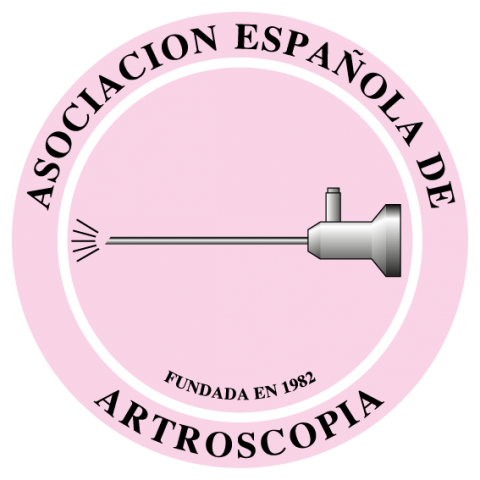

Revista Española de Artroscopia y Cirugía Articular está distribuida bajo una licencia de Creative Commons Reconocimiento-NoComercial-SinObraDerivada 4.0 Internacional.

